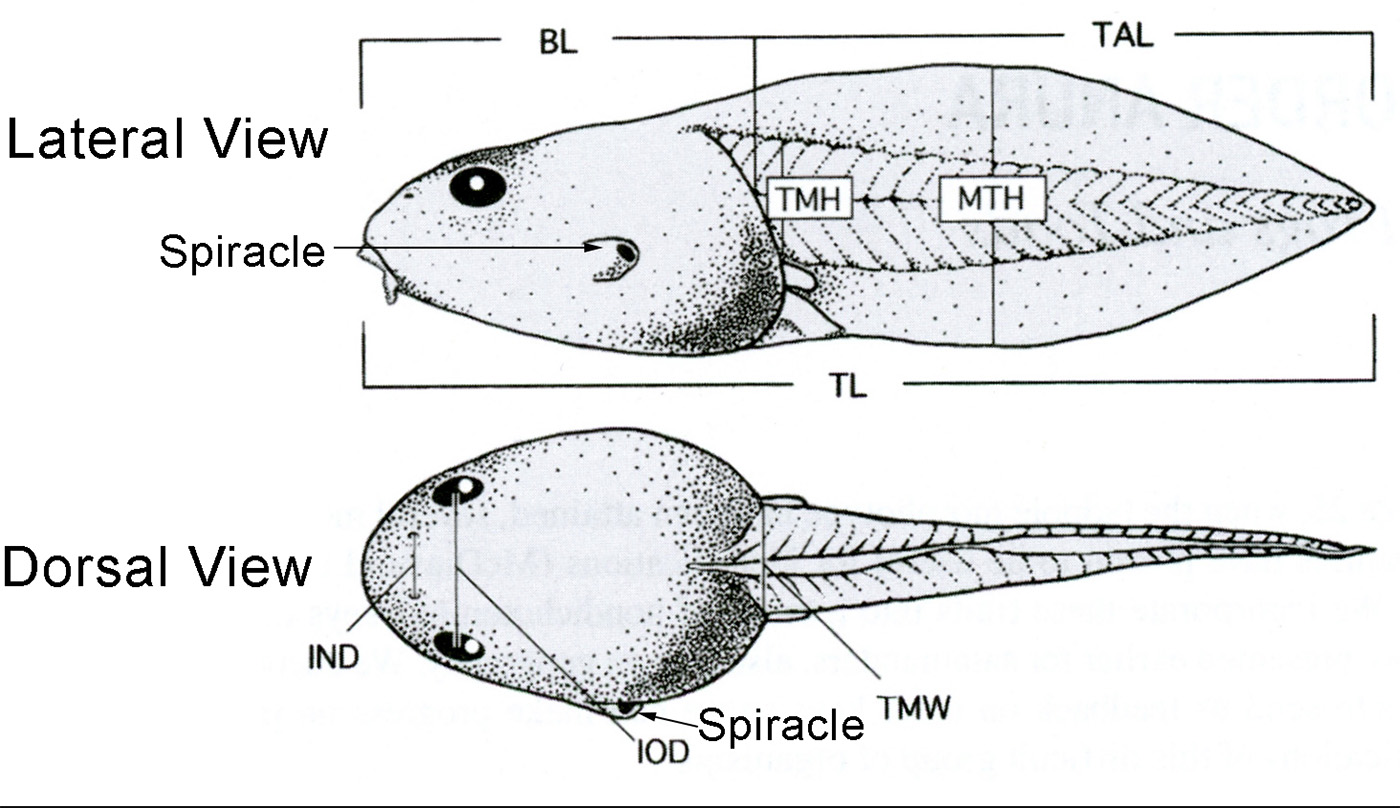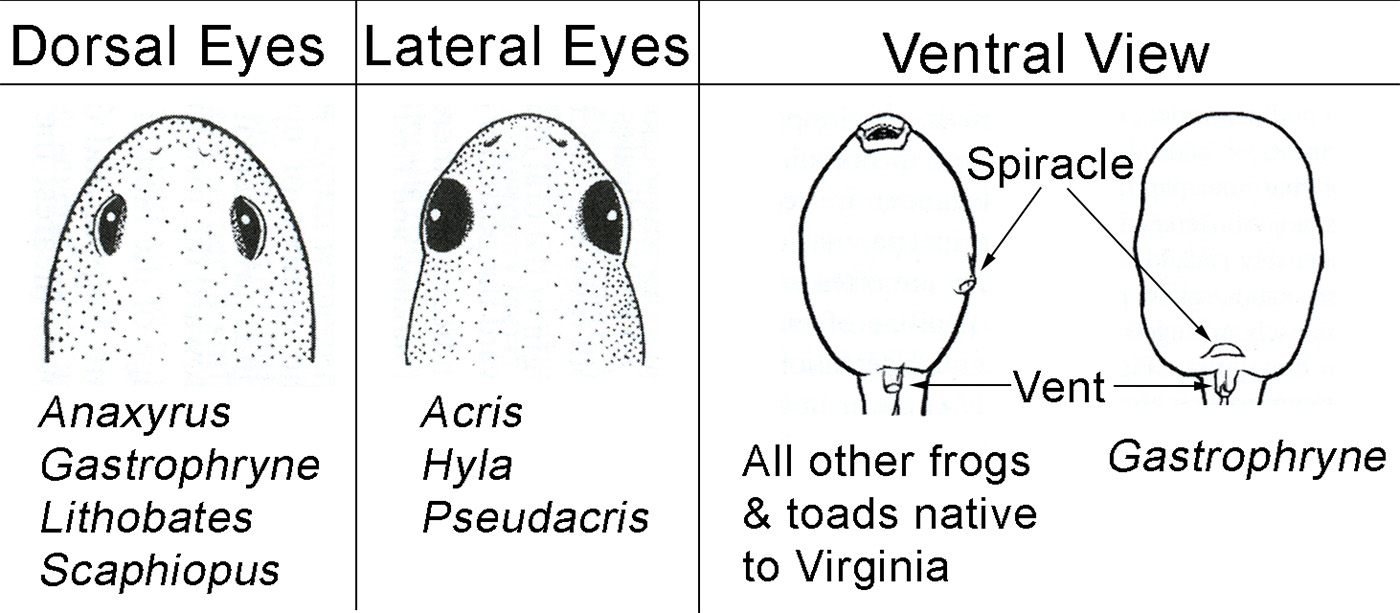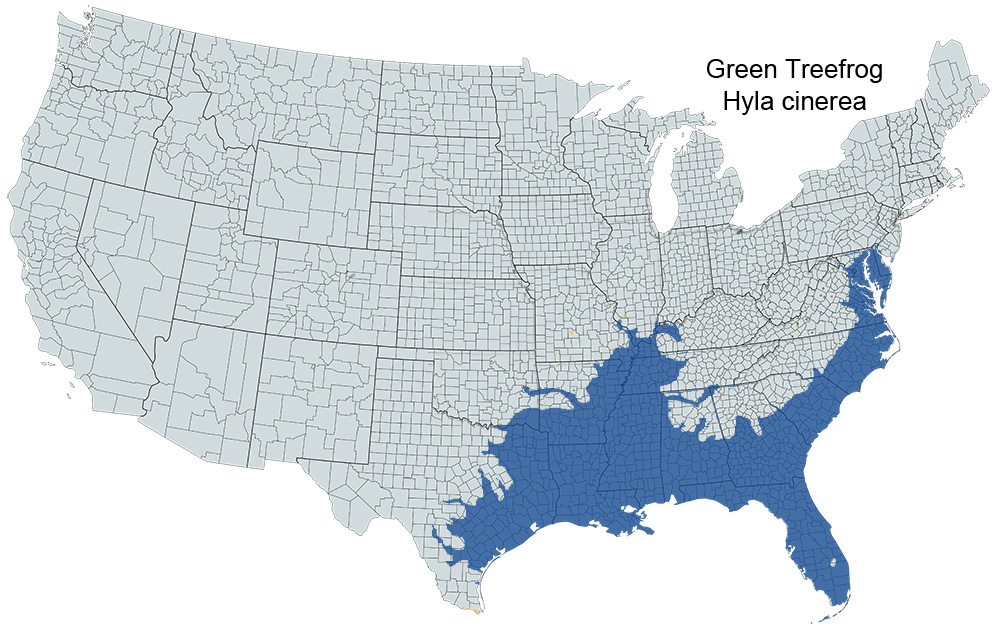Green Treefrog
Dryophytes cinereus
Common Name: |
Green Treefrog |
Scientific Name: |
Dryophytes cinereus |
Etymology: |
|
Genus: |
Dryophytes The name "Dryophytes" is derived from the Greek words "dryos," meaning tree, and "phytes," meaning plant, which refers to the arboreal habits of these frogs. |
Species: |
cinereus is Latin for "ash-colored", Referring to color of a preserved specimen. |
Average Length: |
1.3 - 2.3 in. (3.2 - 5.7 cm |
Virginia Record Length: |
|
Record length: |
2.5 (6.4 cm) |
Physical Description - This is a large but slender hylid species with lengths ranging from 32-64 mm (1.25-2.5 in). It has long legs and smooth skin. The dorsum is typically bright green but variations include a nearly yellow color to a slate gray color. There are typically small golden spots on the dorsum. The ventrum is plain white. There is typically a white or yellowish stripe along the side though its length varies and it may even be absent. The male breeding call is described as a nasal, bell-like "queenk" repeated up to 75 times a minute.
Historical versus Current Distribution - The range of Green Treefrogs (Dryophytes cinereus) extends southward from the Chesapeake Bay region of Delaware, Maryland, and Virginia, through the Carolinas, Georgia, and Florida, then west through most of Alabama and Mississippi, statewide in Louisiana, the eastern half of Texas, and the Red River drainage in southeast Oklahoma. In the Mississippi River drainage, their range extends north from Louisiana and Mississippi through floodplains in southern and eastern Arkansas, western Tennessee, and Kentucky, to extreme southeastern Missouri and southern Illinois (Conant and Collins, 1998; Redmer and Brandon, 2003). Introduced populations occur in Puerto Rico (Schwartz and Thomas, 1975; Rivero, 1978; Schwartz and Henderson, 1985, 1991; Hedges, 1996), Brownsville, Texas (Conant, 1977b; Smith and Kohler, 1977), in central Missouri (Johnson, 1987), and perhaps a coastal island in Florida (Smith et al., 1993). A population that was introduced in east-central Kansas is now probably extirpated (Collins, 1993). There is evidence of recent peripheral range expansion in Illinois (Redmer and Ballard, 1995; Redmer et al., 1999), Missouri (Powell et al., 1995, 1996), and South Carolina (Snyder and Platt, 1997; Platt et al., 1999).
Historical versus Current Abundance - There are few data on Green Treefrog abundance, although there have been few localized reviews of population status. Most authors have commented that they are generally common or locally abundant throughout most of their range (Anderson et al., 1952; Liner, 1954, 1955; O.B. Goin, 1958; Smith, 1961; Bider, 1962; Dyrkacz, 1974; Ackerman, 1975; Mount, 1975; Ashton, 1976; Martof et al., 1980; Bancroft et al., 1983; Gibbons, 1983; Johnson, 1987; Ashton and Ashton, 1988; Dundee and Rossman, 1989; Gibbons and Semlitsch, 1991; Redmond and Scott, 1996; Lannoo, 1998d; Bartlett and Bartlett, 1999a; Mitchell and Reay, 1999; Redmer et al., 1999). There is one report of a localized population decline in Florida (Delis et al., 1996; Dodd and Griffey, 2002).
Breeding - Reproduction is aquatic.
Breeding migrations - There are few data on this topic. Movements from upland habitats into adjacent wetlands have been reported (O.B. Goin, 1958). Roberts and Page (2003) report an instance of a male trying to dislodge an amplectant male.
Breeding habitats - Most data on habitats are based upon adults captured within, or adjacent to, breeding habitat. During the breeding season, adult habitats are variously described as floating or emergent herbaceous vegetation, shrubs, or trees around the margins of aquatic habitats including swamps, sloughs, marshes, ponds, and lakes (Hurter, 1911; Wright, 1932; Carr, 1940a; Jobson, 1940; Cagle, 1942; Goin, 1943; Bartsch, 1944; Neill, 1951a; Werler and McCallion, 1951; Anderson et al., 1952; Moulton, 1954a; Carr and Goin, 1955; Tinkle, 1959; Rossman, 1960; Smith, 1961; Lee, 1969a; Mount, 1975; Garton and Brandon, 1975; McDiarmid et al., 1983; Dundee and Rossman, 1989; Mitchell and Miller, 1991; Scott and Koons, 1993a,b; Redmer et al., 1999).
Egg deposition sites - Oviposition takes place in association with floating mats of vegetation, such as duckweed (Garton and Brandon, 1975; Mount, 1975; Turnipseed and Altig, 1975).
Clutch size - Clutch sizes vary considerably, ranging from 478–1,061 (mean = 700) in southern Illinois (Garton and Brandon, 1975); from 1,348–3,946 (mean = 2,152) in Arkansas (Trauth et al., 1990); and 275–1,160 (mean = 814) in Georgia (Perrill and Daniel, 1983). Green treefrogs may spawn several times over the course of a single prolonged breeding season (Perrill and Daniel, 1983), with minimum fecundities (based on eggs counted from mutiple spawns of single females) calculated to be from 1,088–3,272 (mean = 1,688). However, these authors may not have counted all clutches produced by a single female, so actual fecundity may be substantially higher.
Altig & McDiarmid 2015 - Classification and Description:
- Eastern Clump
- Arrangement 1 - Eggs oviposited as small clumps, not well
formed, surface irregular and not distinctly lobate, eggs often fall apart
as singles soon after oviposition.
- Sub-arrangement B - Eggs deposited in permanent and ephemeral nonflowing water with emergent vegetation; Ovum Diameter 0.8-1.6 mm; Egg Diameter 3.6-4.0 mm; 2 layers.
- Arrangement 1 - Eggs oviposited as small clumps, not well
formed, surface irregular and not distinctly lobate, eggs often fall apart
as singles soon after oviposition.
Length of larval stage - The larval period ranges from 24–45 d (Orton, 1947; Wright and Wright, 1949; Garton and Brandon, 1975; Turnipseed and Altig, 1975; Blouin, 1991, 1992a,b; Blouin and Loeb, 1991).
Tadpoles:

| Lateral View | Dorsal View |
|---|---|
| BL = Body Length | IND = Internarial Distance |
| MTH = Maximum Tail Height | IOD = Interorbital Distance |
| TAL = Tail Length | TMW = Tail Muscle Width |
| TL = Total Length | |
| TMH = Tail Muscle Height |

Larvae Food - Unknown.
Cover - Larval habitat has been reported by Garton and Brandon (1975), Redmer et al. (1999), and Turnipseed and Altig (1975) as ponds with large areas of emergent vegetation. Roth and Jackson (1987) conducted experiments in pools of three sizes and found that tadpole survival was greatest in the smallest pools, which contained the lowest natural densities of predatory insects.
Larval polymorphisms - Tadpoles have been described by or included in keys devised by several authors (Dickerson, 1906; Wright, 1929, 1932; Brimley, 1944; Morris, 1944; Altig, 1970; Cochran and Goin, 1970; Travis, 1981; Ashton and Ashton, 1988; Redmer et al., 1999). Tadpoles are 4.5–5.5 mm TL at hatching and grow to approximately 60 mm before metamorphosis. Ontogenetic color change is continuous until tadpoles reach Gosner (1960) stages 25 or 26, when light blotches fuse to form interorbital and transverse body bands. After this, the tadpoles have a green body, a yellow to buff venter, a yellow tail with dark mottling or reticulations, and distinct yellow orbitonasal stripes. The yellow interorbital stripe present earlier in development is sometimes retained, thus forming a triangle on the head. The tail is long; the distinctly arched dorsal tail fin originates on the back of the body is proportional in height to the ventral fin. Other external characteristics include laterally bulging eyes, a dextral anus, and a sinistral spiracle.
Features of metamorphosis - Tadpoles metamorphose within 28–44 d of hatching (Wright and Wright, 1949; Garton and Brandon, 1975; Turnipseed and Altig, 1975).
Post-metamorphic migrations - At one site in southern Illinois, post-metamorphic juveniles moved to upland habitats < 60 m from the breeding pond (Garton and Brandon, 1975). Elsewhere in southern Illinois, dispersing juveniles were found ≤ 0.5 km from breeding ponds (Redmer et al., 1999). Some of those juveniles were found ≤ 3 mo of the initiation of the breeding season (M.R., unpublished data).
Juvenile Habitat - Juveniles are often found in emergent vegetation in and around breeding ponds, though they may also migrate to adjacent uplands (Garton and Brandon, 1975; Redmer et al., 1999).
Adult Habitat - Green treefrogs are adaptable to a number of habitats, although sites are typically associated with permanent bodies of water containing abundant emergent vegetation. Reported aquatic habitats include swamps, sloughs, marshes, lakes, farm ponds, sewage ponds, fish-farm ponds, flooded borrow pits, flooded sink-holes, and ditches (Hurter, 1911; Wright, 1932; Carr, 1940a; Jobson, 1940; Cagle, 1942; Goin, 1943; Bartsch, 1944; Babbit and Babbit, 1951; Neill, 1951a; Werler and McCallion, 1951; Anderson et al., 1952; Carr and Goin, 1955; Tinkle, 1959; Rossman, 1960; Smith, 1961; Lee, 1969a; R.L. Brown, 1974; Garton and Brandon, 1975; Mount, 1975; Turnipseed and Altig, 1975; Dundee and Rossman, 1989; Scott and Koons, 1993a,b; Phelps and Lancia, 1995; Redmer et al., 1999). Green treefrogs are commonly reported from barrier islands and other coastal areas where they apparently are tolerant of brackish water (Allen, 1932; Dunn, 1937; Oliver, 1955a; Neill, 1958a; Martof, 1963; Diener, 1965; Moore, 1976; Mueller, 1985; Smith et al., 1993; Mitchell and Anderson, 1994). There are a number of reports of refugia or hibernacula, including rock crevices, bird houses, and human litter such as tin cans; Green Treefrogs are frequently found around human dwellings (O.B. Goin, 1958; Tinkle, 1959; Grzimek, 1974; Garton and Brandon, 1975; Delnicki and Bolen, 1977; McComb and Noble, 1981). PVC pipes placed as artificial refugia have been used in efforts to sample this and other species of Dryophytes (Mouton et al., 1997).
Home Range Size - Unknown.
Territories - Unknown, but adult males are known to defend calling sites (Garton and Brandon, 1975).
Aestivation/Avoiding Dessication - Unknown, but studies of temperature and water balance have emphasized thermoregulation (O.B. Goin, 1958; Freed, 1980b), body temperatures (Brattstrom, 1963, 1968), cooling (Wygoda, 1988b), factors affecting evaporative water loss (Wygoda, 1984, 1988a,b, 1989a,b; Wygoda and Williams, 1991; Wygoda and Garman, 1993), fever (Kluger, 1977; Muchlinsky, 1985), thermal acclimation/tolerances (Brattstrom, 1963; Layne and Romano, 1985; Blem et al., 1986; Layne et al., 1989), tolerance of desiccation (Layne et al., 1989), and water absorption (Walker and Whitford, 1970). Ballinger and McKinney (1966) reported a lower lethal developmental temperature of 20 ˚C.
Seasonal Migrations - Unknown, but juveniles will disperse onto wooded hillsides and into open fields (Bartsch, 1944; Garton and Brandon, 1975; Redmer et al., 1999).
Torpor (Hibernation) - Captive specimens become lethargic, and movements are uncoordinated at temperatures below 16 ˚C (M.R., unpublished data; for further information see "Aestivation/Avoiding Dessication" above).
Interspecific Associations/Exclusions - A number of authors have reported associations with other species of anurans that reproduce in similar habitats, for example northern cricket frogs (Acris crepitans), southern cricket frogs (A. gryllus), bird-voiced treefrogs (Dryophytes avivoca), American bullfrogs (Rana catesbeiana), and green frogs (R. clamitans; Wright, 1932; Cagle, 1942; Livezey and Johnson, 1948; Wright and Wright, 1949; Peterson et al., 1952; O.B. Goin, 1958; Brown and Pierce, 1965; Hardy, 1972; Garton and Brandon, 1975; Turnipseed and Altig, 1975; Moore, 1976; Trauth, 1992; Grimké and Jaeger, 1998; Redmer et al., 1999).
Numerous studies report on interspecific isolating mechanisms or their failure, producing hybridization, between this and other hylids (Blair, 1958b; Mecham, 1960b, 1965; Littlejohn, 1961; Pyburn and Kennedy, 1961; Kennedy, 1964; Lee, 1968a; Fortman and Altig, 1974; Gerhardt, 1974b; Oldham and Gerhardt, 1975; Pierce, 1975; Ralin, 1977b; Anderson and Moler, 1986; Schlefer et al., 1986; Lamb and Avise, 1986, 1987; Lamb, 1987; Maxon et al., 1987; Lamb et al., 1990; and Mable and Rye, 1992).
Age/Size at Reproductive Maturity - Uncertain. Based on growth rates, several authors have suggested that sexual maturity is reached in the second year of life (O.B. Goin, 1958; Garton and Brandon, 1975). Other demographic information is based primarily upon studies of growth (O.B. Goin, 1958; Garton and Brandon, 1975; Blouin, 1991, 1992a,b).
Longevity - Unknown.
Feeding Behavior - Their postmetamorphic diet includes a variety of arthropods and other small invertebrates (Haber, 1926; Kilby, 1945; Oliver, 1955a; R.L. Brown, 1974; Freed, 1982a; Ritchie, 1982). Green treefrogs are visually-oriented predators that respond to prey size, shape, and speed (Deban and Nishikawa, 1992; Freed, 1980a,b, 1982a,b, 1988; and Hueey, 1980). Leips and Travis (1994) studied the effects of food availability on newly metamorphosed animals.
Predators - Reported by a number of authors to consist of a variety of vertebrates, including several species of snakes and wading birds, and invertebrates, including spiders (Wright, 1932; Wright and Wright, 1949; Bowers, 1966; Jenni, 1969; Garton and Brandon, 1975; Schardien and Jackson, 1982; Lockley, 1990; Bishop and Farrell, 1994; Mitchell, 1994a; Palmer and Braswell, 1995).
Anti-Predator mechanisms - Behavioral defense by adults was reported by Marchison and Anderson (1976). There is some evidence that Green Treefrog tadpoles are more unpalatable to predatory fishes than are tadpoles of related barking treefrogs (D. gratiosa; Blouin, 1990).
Diseases - Unknown, but the effects of environmental contaminants on larval development and behavior have been studied (Webber and Cochran, 1984; Mahaney, 1994). For example, Jung and Jagoe (1995) demonstrated that aluminum, often present in elevated concentrations in acidifed waters, can have lethal or non-lethal effects. Among the non-lethal effects, exposed tadpoles demonstrate slower swimming speeds, which increases their vulnerability to predators. The distribution of radiocesium in a contaminated population has also been studied (Dapson and Kaplan, 1975).
Parasites - Endoparasites reported from this species include several helminths (Steiner, 1924; Brooks, 1979), and a Basidobolus sp. (Okafor et al., 1984). Transmission of a trypanosome to this species (by a dipteran) has been described (Johnson et al., 1993). McKeever (1977) has observed mosquitoes preying on adults. Green treefrogs may be beneficial to some agricultural crops because they are a known vector of a blight (Colletotrichtum gloeosporioides) known to affect certain vetch plants considered to be weeds (Yang and TeBeest, 1992; Yang et al., 1992).
Conservation - Though there have been few localized reviews of population status, it is generally agreed that Green Treefrogs are common or locally abundant throughout most of their range. There is one report of a localized population decline in Florida, and reports of recent range expansion in Illinois, Missouri, and South Carolina (see "Historical versus Current Distribution" and "Historical versus Current Abundance," above). They are not protected under any state or federal laws.
References for Life History
- Altig, Ronald & McDiarmid, Roy W. 2015. Handbook of Larval Amphibians of the United States and Canada. Cornell University Press, Ithaca, NY. 341 pages.
- AmphibiaWeb. 2020. University of California, Berkeley, CA, USA.
- Conant, Roger and, Collins, John T., 2016, Peterson Field Guide: Reptiles and Amphibians, Eastern and Central North America, 494 pgs., Houghton Mifflin Company., New York
- Duellman, William E. and, Trueb, Linda, 1986, Biology of Amphibians, 671 pgs., The Johns Hopkins University Press, Baltimore
- Martof, B.S., Palmer, W.M., Bailey, J.R., Harrison, III J.R., 1980, Amphibians and Reptiles of the Carolinas and Virginia, 264 pgs., UNC Press, Chapel Hill, NC
- Wilson, L.A., 1995, Land manager's guide to the amphibians and reptiles of the South, 360 pp. pgs., The Nature Conservancy, Southeastern Region, Chapel Hill, NC
Photos:
*Click on a thumbnail for a larger version.
Verified County/City Occurrence
Accomack
Amelia
Arlington
Brunswick
Caroline
Charles City
Chesterfield
Craig
Dinwiddie
Essex
Fairfax
Gloucester
Goochland
Greensville
Hanover
Henrico
Isle of Wight
James City
King and Queen
King George
King William
Lancaster
Louisa
Lunenburg
Mathews
Mecklenburg
Middlesex
New Kent
Northampton
Northumberland
Nottoway
Powhatan
Prince Edward
Prince George
Prince William
Pulaski
Richmond
Southampton
Spotsylvania
Stafford
Surry
Sussex
Westmoreland
York
CITIES
Alexandria
Chesapeake
Hampton
Newport News
Poquoson
Portsmouth
Richmond
Suffolk
Virginia Beach
Williamsburg
Verified in 44 counties and 10 cities.
U.S. Range















